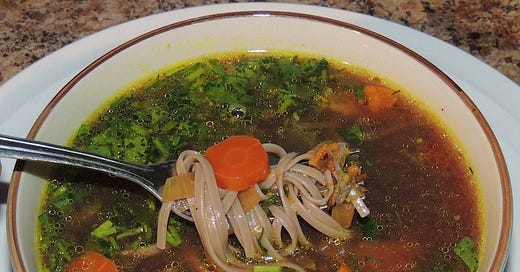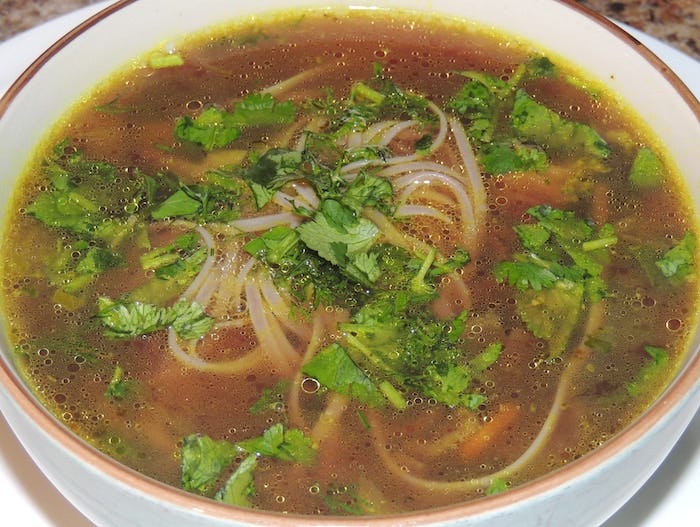Vegetarian Khao Poon
This vibrantly flavored soup is a reflection of the diversity of the ecosystem, cultivation method and beautiful culture that inspired it.
I have decided I will be sharing one recipe from my book (Recipes For Reciprocity: The Regenerative Way From Seed To Table) per week for the next month to give all my kind and generous Substack subscribers a sneak peak and taste of what is in my book (which was just released in eBook format).
Since some of us in the temperate regions of the northern hemisphere are gonna have to get to work outside soon (whether it is in the garden or at our day job) the first recipe I share will be for a hearty and extremely nourishing soup inspired by Laotian cuisine (which is great for bringing to work in a thermos to keep your core warm and fuel a hard day’s work).
The following is my own take on an extremely nutritious and healing traditional Laotian soup called Khao Poon.
Combine a rainbow of veggies and herbs with fresh turmeric, ginger, garlic, simmer to fuse the flavors into a broth...add fresh greens and noodles and what do you get? Vegetarian Khao poon is what! :)
This enticing soup offers a full spectrum of antioxidants, minerals, protein and vitamins and boasts floral, spicy, umami, and sweet flavor notes that make you want to come back for a second and third bowl!
Not only is it nutritious and delicious it also offers a potent array of immune system boosting compounds that will send just about any cold, flu or case of the sniffles packing.
We love to create this when we harvest our turmeric and ginger plants so we can incorporate the fresh organic rhizomes into a meal at their peak potency.
I will be including info in the book with tips for growing ginger and turmeric rhizome in pots.


I hope you enjoy this passport for your senses to explore the beauty of Laos (while optimizing immune function and super charging your day).
Ingredients:
- 1-7 cloves Garlic, crushed
- 2-4 Jalapenos (or another hot chili), chopped
- 2-4 teaspoons Ginger (grated or diced)
- 3-4 teaspoons Turmeric (grated fresh)
- 1-2 teaspoons Galangal (sliced fresh or dried)
- 1-2 Lemongrass stalks (outer shell removed, smashed)
- 1/2 - one whole bunch of Cilantro (stems boiled, leaves saved for garnish)
- 2 Carrots, sliced
- a handful of ginger or turmeric leaves (optional)
- Shallots (sliced)
- Keffir lime leaves
- a sprinkle of Wakame (dried seaweed) optional
- some broth / broth concentrate (optional)
- 3-5 Sichuan peppercorns, crushed (optional)
- 1 cup, broccoli, cut into bite-sized chunks
- 1-2 red onions, sliced
- 1 cup kale chopped
- 1 cup watercress, chopped
- ½ cup fresh dill, parlsey and/or mint, chopped
- 1 cup spinach chopped
- 1 cup bok choy chopped
- ¼ of a small purple/red cabbage, sliced thinly
- 1 medium-sized sweet potato, sliced thinly
- 2 stalks celery, chopped
- ½ cup wild rice
- ½ cup black or red rice
- ½- a full cup sliced shiitake mushrooms
Other delicious, medicinal and/or nutritious optional seasonal ingredients
- Nettle
- Wild Spinach (aka “lambsquarters”)
- some Rhodiola Rosea or Rhodiola integrifolia root powder
Preparation:
Sauté the onions, celery, mushrooms and dry rice in a large pot until onions are translucent.
Add all the rest of the ingredients to the pot (reserving about 1/4 of all the chopped fresh greens and herbs for garnishing each bowl before serving).
Add enough water to cover ingredients three inches deep, bring to a boil and then simmer for 10-15 minutes (or until wild rice begins to soften).
Then add chopped kale, watercress, bok choy and spinach (any nutritious greens) to bowl and add either cooked noodles or rice.

Add dill (if using) then broth... garnish with cilantro leaves and perhaps some soya or tamari sauce. Serve hot. Will keep in fridge for up to one week. Can be frozen without the noodles.
I hope some of you will give making it a try and tell me what you think.
I personally love this soup since we grow so much ginger and turmeric rhizome and the soup freezes well (if you freeze it without the noodles). The addition of garnishes like diced watercress, mint and/or cilantro really take the vibrant flavors, powerful detoxing effects and nutritional spectrum offered by this soup to the next level.
Based on what a Laotian friend told me, the diverse ingredients/nutrients in recipes like the one I shared above are really a perfect reflection of what some isolated forms of sustainable (and sometimes even Regenerative) agriculture in Laos looked like maybe 20-50 years ago (depending on the area).
He told me about some of the river valleys he had visited when he was young that involved incrementally terraced rice cultivation systems that also had fish in them.
Known as rice fishing, or a rice-fish system, the technique integrates rice agriculture with aquaculture, most commonly with freshwater fish but also crabs, crayfish, and other sources of food and crop nutrients. It is a tradition passed down from generation to the next in certain parts of the world and in Laos I am told that it incorporated a polyculture of crops (several varieties of heirloom rice, watercress, reed species with edible rhizomes and lots of other stuff) and then they also farmed several varieties of fish in there at the same time.
Then my friend told me how over multiple generations some villages had created multi-layered tropical forest gardens beside these rice plantations and would forage in the jungle for diverse herbs and rhizomes (like turmeric) and make it all into vibrant soups like the one above (or amazing “Buddha Bowl” type salad dishes).
Sadly, much of the jungle is being “developed” and the line of traditional cultivation knowledge has been all but broken by a generation of youth more interested in high tech distractions and high paced city life. There are some people tryna preserve the traditional regenerative cultivation practices but it is not looking good so I wanted to try and preserve a little bit of that unique culture and way of growing/preparing food in my book (which resulted in the recipe above).
It is worth noting that some of the “rice-fish cultivation systems” being used in China, India, Vietnam and Laos are not much more than a monocrop of two species (one type of rice and one type of fish) when is not really something that could be considered as regenerative or biodiverse. Still, it is a step in the right direction and something for us to build and improve on if we want to continue to cultivate rice and do so in a way that also honors ecosystems and provides nutrient dense (contaminant free) food.
For for info on the “rice-fish system” and it’s potential for integrating as part of a regenerative food cultivation system see:
https://www.oneearth.org/the-ancient-tradition-of-rice-fishing-has-multiple-modern-benefits/
“Using aquatic animals as partners to increase yield and maintain soil nitrogen in the paddy ecosystems” : https://elifesciences.org/articles/73869
Mixed farming increases rice yield : https://www.renature.co/articles/mixed-farming-increase-rice-yield/
Cultivating rice with aquatic animals naturally boosts production : https://www.ecowatch.com/rice-farming-sustainability-pesticides.html
I am sharing this recipe so that anyone who feels compelled to create it can benefit from it's immune system optimizing benefits if they end up feeling under the weather this spring and so that you can have access to a “passport for your senses” to be able to explore and engage with the land and culture of a far away beautiful place (even if you cannot travel there physically).
So whether it is for keeping your immune system in tippy-top shape or just exploring a unique culturally enriching food, I hope you all enjoy this tasty recipe! :)
When you cultivate food in the garden in a way that gives back to the living Earth and honors the many gifts we have been given in this life, you are engaging in a sort of Spiritual Reciprocity by creating nourishing foods with those crops in the kitchen. Using your hands to give back to the Earth and to give thanks to Creator for the gift you have been given in this human body, by taking good care of it with nourishing, delicious and vibrant meals (that use food as medicine and provide poetry for the soul) is a way to give back to your body, your temple and thus a way to give back and say thank you to Creator.
One of the most powerful choices we can make to heal the relationship to Mother Earth, give back to and honor our sacred temple and in doing so engage in an act of Spiritual Reciprocity begins with a handful of seeds and some TLC.
I am wishing you all a spring time filled with hope, peace, feeling nourished and inspired by the abundance you cultivate and create in the garden and in the kitchen.












Yum!
LOVE the Aurora of the Anti-Oxidants!